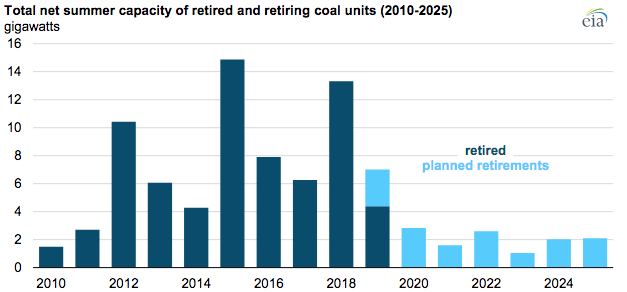In 2010, coal-generated 45 percent of the nation’s electricity with 317 gigawatts of coal-fired generating capacity—30 percent of the generating fleet. Last year, the United States generated only 24 percent of its electricity from coal and coal-fired generating capacity fell to 234 gigawatts (as of October 2019). Between 2010 and the first quarter of 2019, U.S. power companies announced the retirement of over 546 coal-fired power units, totaling about 102 gigawatts of generating capacity. Plant owners intend to retire another 17 gigawatts of coal-fired capacity by 2025, according to the Energy Information Administration (EIA). Coal-fired plants have been retired due to regulation beginning with the Mercury and Air Toxics Standards promulgated by the Obama Administration, competition from low-cost natural gas and heavily subsidized and mandated renewable (mainly wind and solar) plants, and relatively flat electricity demand growth.

According to the EIA, plant owners retired 13.7 gigawatts of coal-fired generation capacity in 2018—the second-highest annual total for U.S. coal retirements in the agency’s dataset; the highest total for coal retirements—15 gigawatts—was in 2015.
Most of the 2019 coal retirements were scheduled to occur at the end of the year. The 2019 coal-fired capacity retirements were relatively small compared with the 13.7 gigawatts that retired in 2018. About half of the planned retirement capacity for coal in 2019 was at a single plant, the 2.25 gigawatt Navajo Generating Station, located in Arizona that came online in 1976 and closed on November 18, 2019. The plant was the largest coal plant in the West.
More coal units are slated for retirement in 2020. Of the 5.8 gigawatts of coal-fired capacity that EIA expects to retire in 2020, about half of that capacity is located in Kentucky and Ohio. The retirement of Unit 3 at the Paradise plant in Kentucky (0.97 gigawatts) will be the largest coal-fired unit to retire in the United States in 2020. The next-largest retirements will be at Elmer Smith in Kentucky and at Conesville (Unit 4) and W H Sammis (Units 1–4) in Ohio.
For the first 10 months of 2019, carbon dioxide emissions fell by 2.2 percent compared to the first 10 months of the previous year. Most of that decline came from a 12 percent decline in carbon dioxide emissions from coal, which contributed to a 7 percent decline in carbon dioxide emissions from the generating sector overall in the period.
Conclusion
Coal had been the primary fuel for U.S. power plants for much of the last century, but its use has been declining since its peak in 2007—about when drillers figured out how to economically obtain natural gas from shale formations. But the large increases in retirements began after the Mercury and Air Toxics rule went into effect in 2011 and utility owners found it was not profitable to add mercury controls to previously exempt coal-fired units. State mandates of renewable energy along with relatively flat or decreasing electricity demand in the post-2010 period also affected coal-fired retirements. Since 2000, roughly half of all renewable energy growth can be attributed to state-mandated policies for renewable energy, according to the Berkeley Laboratory.
Natural gas overtook coal as the leading fuel for U.S. electric generation in 2016 and, ever since, its generation has continued to exceed that of coal. Renewable generation has also continued to grow. Wind power has multiplied by almost a factor of 50 between 2010 and 2018; solar power has increased by almost a factor of 130 between 2010 and 2018. But together, they combined for just 8 percent of the nation’s electric generation in 2018.
But, since coal’s peak in 2007, residential electricity prices have increased by 23 percent despite generally falling coal and natural gas costs to electric utilities. Clearly, the era of coal as the U.S. major generating fuel seems to be a bygone era and so are the lower electricity prices seen in coal generation’s heyday.